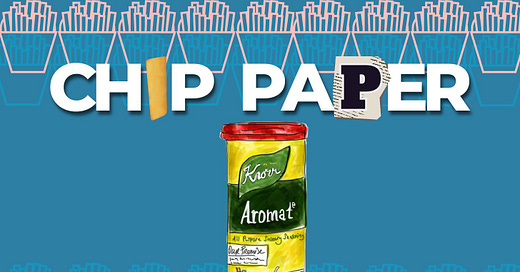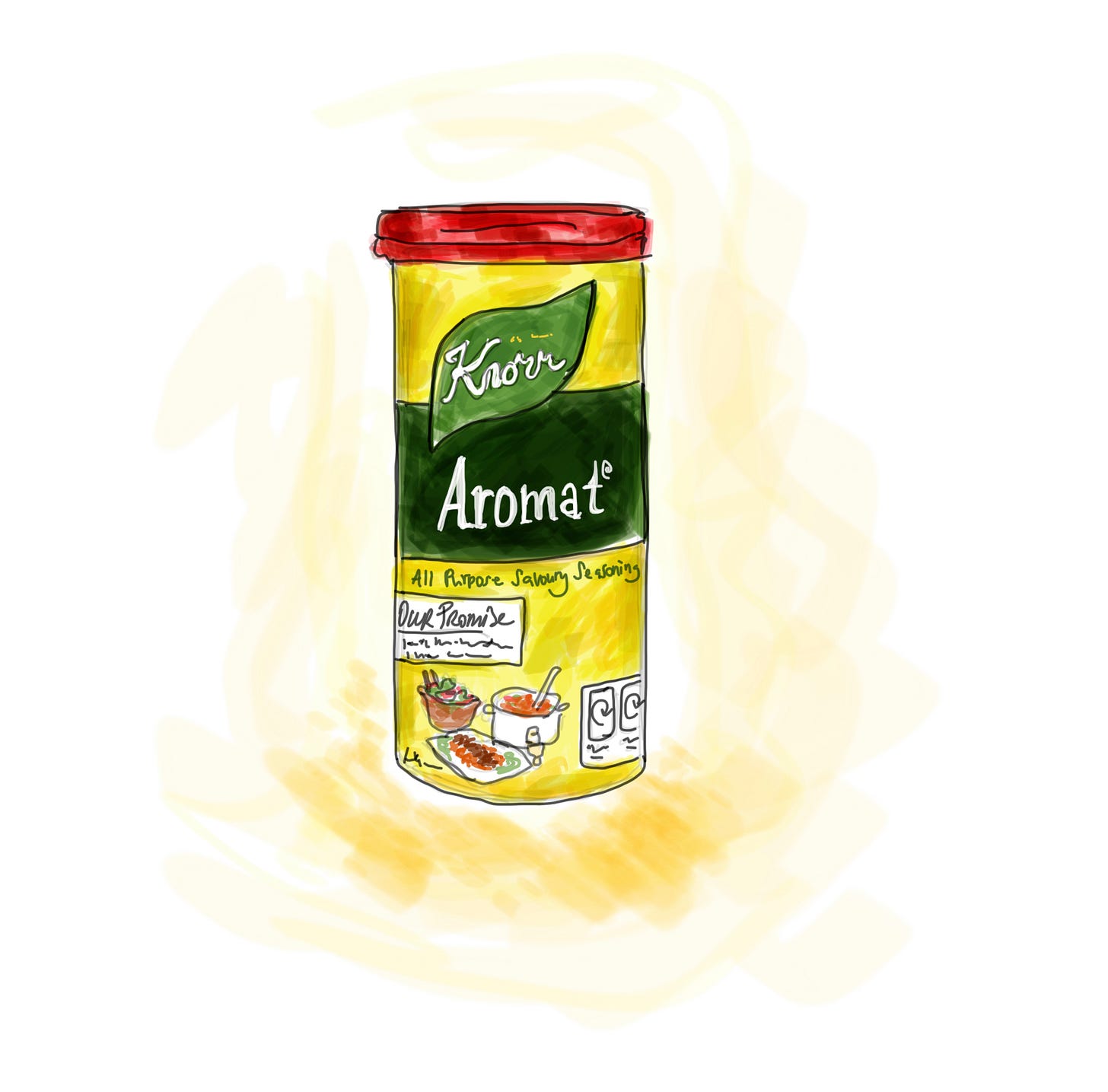Condiment Curiosity: Aromat
Knorr's keenly-balanced blend of savoury seasoning levels up flavour in food (yes, it contains MSG) and has endured as a serial kitchen cupboard classic since the 1950s. Let's deep dive into Aromat...
Origins of Aromat
In 1912, Knorr brought their revolutionary ‘bouillon’ stock cubes to market, but Knorr wasn’t new to the world. A German company, headquartered in Heilbronn, Knorr had already been around for almost 75 years and originally began in business by producing chicory for the coffee industry. The bouillon cube was their major hit, but it wasn’t until 1949 when those iconic cubes landed in the UK and Ireland, closely followed four years later by another lasting icon: Aromat. Developed by a Swiss chef in their team, Aromat was originally almost indistinguishable from its stock cube sibling, bearing the same compacted cube form but called Pflanzenextract (plant extract). However, a year into production they changed both the name and the form, now a pinch-able, loose seasoning called Aromat. The rest is history, and Knorr now sits as just one of countless labels owned by a brand name behemoth, the multinational household consumer goods company Unilever.
Where stock cubes provided a hearty, humble base to add to liquid for lots of dishes, Aromat was a step in a different direction: a “finely balanced blend of herbs and spices, carefully selected to bring out the best in your cooking”. Similar products - in theory - both offering express ease in flavour building, but set apart by being used at different stages or methods of cooking. Maybe a simplified, bastardised definition could be that stock cubes are best to sit around ingredients in a dish (broth, soup, sauce) whereas Aromat sits directly on ingredients in a dish, coating, covering, spicing and seasoning specific elements.
Essentially Aromat is a catch-all seasoning. We saw a tweet once saying “Knorr Aromat is just salt that went to private school” and indeed Knorr itself suggests you use it to season food “just like salt and pepper” –– though, notably, the standard product doesn’t actually contain pepper. The ingredients tell us it’s got garlic, onion, mushroom, turmeric, bay leaf, clove, celery and lactose (milk) whilst - aside from the herbs and spice elements - Aromat also contains the likes of yeast extract and Monosodium Glutamate (MSG); more on MSG in a bit.
Aromat eventually got a spicier sibling to shake things up. Though they share many ingredients in their make-up, the red-labelled ‘For Meat’ version also boasts cardamom, tarragon, paprika, basil, cumin, cayenne, chervil, and boletus edulis (a type of edible funghi). A hint spicier, more complex and sweeter. Less herbal than the original but the spicier elements seem to make it feel saltier, too. It’s darker, deeper and a more pronounced ‘spice’ scent, almost masala-like or maybe closer to its Gallic interpretation, vadouvan.
Where the Swiss are, you’ll find Aromat…
Hannah Barkhoff, a Market Specialist with Bord Bia focused on the German-speaking regions of Europe (Germany, Austria, Switzerland), comes from a German-Swiss family and grew up in Ireland. She tells us Aromat was never far from the table, explaining “where the Swiss are, you’ll find Aromat,” adding “Aromat is also popular in Germany but you wouldn’t find it as widespread in the north of Germany, more so in the southern regions, closer to the Swiss border.” Zoning in on its Swiss popularity (where it’s still produced to this day) Hannah says Aromat is probably less popular today in kitchens as it once was, explaining “probably down to negative press around glutamate and MSG plus the trend to more health-focused diets… but who knows how sexy and popular Aromat would be today if it had the buzzword ‘umami’ tied to it and some Umami-led marketing spiel and clever packaging.”
Neil Mac Aogain, an Irish man living in Switzerland for a number of years, tells us “it’s everywhere, Swiss restaurants will have salt, pepper and Aromat on the table as options for seasoning, though I only started using it since I moved here”. Neil explains that the Swiss generally enjoy Aromat quite simply on potatoes, pasta and salads, but with eggs it’s particularly prominent — “you can even buy two-pack “picnic” hardboiled eggs with Aromat seasoning already on them in the supermarkets,” he divulges –– and now we want to visit Switzerland more than ever.
Hannah also throws a slight curveball to the conversation by introducing Maggi and Fondor. “Nestlé has a version of Aromat called Fondor,” she explains, “which is the dried sprinkle equivalent of what Maggi is in liquid form. Maggi - also a Swiss product - is probably more popular than Aromat in both Germany and Switzerland, and, as a Swiss/German family living in Ireland for over 26 years, we were always on the hunt for Maggi”. Continuing, Hannah says “It's not available in Ireland except for a Polish version (found in some Eastern European delis/supermarkets) and as Aromat became more available over the years in Ireland we never needed to stow in our luggage, but whenever one of us was in Germany or Switzerland they would have to bring back a few bottles of Maggi”. Not solely restricted to Central Europe and the British and Irish Isles, Aromat is also extremely popular in South Africa.
“A toxic chemical and carcinogen”; “very bad for you”; “can’t get enough of it”
In our research of truly understanding all about Aromat we took a bit of a social media straw poll and came across a large group of people who exclaimed “love” or “adore” the moment the product was mentioned. This pool regaled us with their uses and memories, some more lighthearted but lots absolutely coveting Aromat in their cookery. They exclaimed things like “Dynamite… rocket fuel… addicted… can’t get enough of it… miracle workers… obsessed… can’t live without it…” Naturally, we also found a small group who had “never tried” it or queried “what do you do with it?,” which was to be expected. In fact, our own editor and publisher of our book, Hot Fat, Kristin Jensen - who has worked in food in Ireland for over 20 years - had never had it until we told her about it!
However another group, albeit small but not insignificant, emerged using words like “scared” or “gross” often followed by some form of “bad for you” warning. Some went further with their charges, “gives me migraines… pure evil/vile… told as children it gives you cancer, couldn’t understand why it was sold… heard it killed rats… so gross… pure carcinogenic… basically MSG in a tin… VERY bad for you/full of bad stuff…” This is nothing new, but a fairly old-fashioned view and one which we believe needs to be challenged.
You can’t fight it, MSG is found within Aromat; it’s the second-largest ingredient found within after salt. MSG has, of course, been wrapped in controversy and sold down the river in the past. We’re neither scientists nor researchers and actually not even that science-minded but let us try to distill what MSG is in simple terms: Monosodium Glutamate is a sodium form of a non-essential amino acid, a building block of protein in the body. Non-essential means glutamate is already found naturally in the body but also ingested dietarily in food stuffs. Naturally-occurring in things like parmesan, mushrooms and tomatoes, but also added to other ingredients in a salt form like MSG. Unlocking ‘umami’ was down to Japanese scientist Kikunae Ikeda, who, in 1908, first identified glutamic acid as the primary source of umami ––that concentrated deliciousness that offers a savoury depth to food and comprises the fifth ‘taste’. A year later, Ikeda began producing this substance on scale and selling it to market.
In recent years, umami has become lauded by chefs and writers and a buzzword becoming part of the culinary vernacular worldwide, so why the distaste for MSG when ‘umami’ is the flavour on everyone’s lips? This 2013 Smithsonian article by Natasha Geiling explains the phenomenon and controversy especially well (we implore you to read). It’s particularly interesting to note the Umami Burger example, whereby a burger chain receives cult status and hour-long queues for burgers which celebrate naturally-occurring umami, but therein the body is ingesting glutamate in eye-watering levels. The body digests glutamate as glutamate, and breaks it down as such in the same way, whether from Portobello mushrooms or from MSG; or from Aromat, for that matter.
Keep reading with a 7-day free trial
Subscribe to Chip Paper to keep reading this post and get 7 days of free access to the full post archives.





